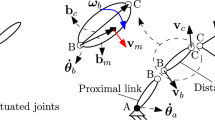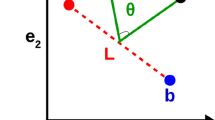Abstract
The efficient algorithm for high-order inverse dynamics of serial robots is an essential need in design and model-based control of robots equipped with serial elastic joints. Although several efficient algorithms have been proposed, the introduction of new frameworks can lead to new understanding and further improvements. Based on the projective geometric algebra (PGA) for Euclidean geometry, this paper provides a recursive algorithm that is computationally efficient, intuitive, uniform, and coordinate invariant. In the PGA-based method, calculations of the exponential map and Lie brackets are simplified and rigid body motions are represented as vectors instead of matrices. All geometric elements used to model robots are represented as vectors uniformly, and all operations are modeled as algebraic operations with explicit geometric meaning. The validation of the algorithm is presented for the second-order inverse dynamics of the Franka Emika Panda using the algorithm based on PGA and the algorithm based on product of exponentials (POE) respectively. The proposed algorithm is 15% faster than the POE-based algorithm with correct results. It turns out that the kinematics part of the algorithm saves 69.82% multiplications and 73.58% additions than that in the POE-based algorithm. The relation between PGA and other popular concepts in robotics, such as dual quaternions, is also discussed.








Similar content being viewed by others
Notes
The data file can be downloaded from https://ieeexplore.ieee.org/ielx7/7083369/9285111/9290369/lra-3044028-mm.zip?arnumber=9290369.
References
Gattringer, H., Springer, K., Müller, A., Jörgl, M.: An efficient method for the dynamical modeling of serial elastic link/joint robots. In: Moreno-Díaz, R., Pichler, F., Quesada-Arencibia, A. (eds.) Computer Aided Systems Theory – EUROCAST 2015. Lecture Notes in Computer Science, pp. 689–697. Springer, Cham (2015). https://doi.org/10.1007/978-3-319-27340-2_85
Müller, A.: An o(n)-algorithm for the higher-order kinematics and inverse dynamics of serial manipulators using spatial representation of twists. IEEE Robot. Autom. Lett. 6(2), 397–404 (2021). https://doi.org/10.1109/LRA.2020.3044028
Oaki, J., Adachi, S.: Vibration suppression control of elastic-joint robot arm based on designless nonlinear state observer. IEEJ Trans. Ind. Appl. 135(5), 571–581 (2015). https://doi.org/10.1541/ieejias.135.571
Bruzzone, L., Bozzini, G.: A statically balanced SCARA-like industrial manipulator with high energetic efficiency. Meccanica 46(4), 771–784 (2011). https://doi.org/10.1007/s11012-010-9336-6
Feng, H., Xu, Y., Mao, D.: A novel adaptive balance-drive mechanism for industrial robots using a series elastic actuator. Int. J. Comput. Integr. Manuf. 33(10–11), 991–1005 (2020). https://doi.org/10.1080/0951192X.2020.1736715
Denavit, J., Hartenberg, R.S.: A kinematic notation for lower-pair mechanisms based on matrices. J. Appl. Mech. 22(2), 215–221 (1955). https://doi.org/10.1115/1.4011045
Lynch, K.M., Park, F.C.: Modern Robotics. Cambridge University Press, Cambridge (2017)
Chen, G., Kong, L., Li, Q., Wang, H., Lin, Z.: Complete, minimal and continuous error models for the kinematic calibration of parallel manipulators based on POE formula. Mech. Mach. Theory 121, 844–856 (2018). https://doi.org/10.1016/j.mechmachtheory.2017.11.003
Selig, J.M.: Geometrical Foundations of Robotics. Springer, New York (2005). https://doi.org/10.1007/b138859
Müller, A., Kumar, S.: Closed-form time derivatives of the equations of motion of rigid body systems. Multibody Syst. Dyn. 53(3), 257–273 (2021). https://doi.org/10.1007/s11044-021-09796-8
Müller, A.: An overview of formulae for the higher-order kinematics of lower-pair chains with applications in robotics and mechanism theory. Mech. Mach. Theory 142, 103594 (2019). https://doi.org/10.1016/j.mechmachtheory.2019.103594
Singh, S., Russell, R.P., Wensing, P.M.: Efficient analytical derivatives of rigid-body dynamics using spatial vector algebra. IEEE Robot. Autom. Lett. 7(2), 1776–1783 (2022). https://doi.org/10.1109/lra.2022.3141194
Cibicik, A., Egeland, O.: Kinematics and dynamics of flexible robotic manipulators using dual screws. IEEE Trans. Robot. 37(1), 206–224 (2021). https://doi.org/10.1109/tro.2020.3014519
Silva, F.F.A., Quiroz-Omaña, J.J., Adorno, B.V.: Dynamics of mobile manipulators using dual quaternion algebra. J. Mech. Robot. 14(6), 061005 (2022). https://doi.org/10.1115/1.4054320
Crowe, M.G., Williamson, R.E.: A History of Vector Analysis, vol. 37, p. 844 (1969). https://doi.org/10.1119/1.1975883
Hestenes, D.: Spacetime physics with geometric algebra. Am. J. Phys. 71(7), 691–714 (2003). https://doi.org/10.1119/1.1571836
Doran, C., Gullans, S.R., Lasenby, A., Lasenby, J., Fitzgerald, W.: Geometric Algebra for Physicists. Cambridge University Press, Cambridge (2003). https://doi.org/10.1017/CBO9780511807497
Lopes, W.B., Lopes, C.G.: Geometric-algebra adaptive filters. IEEE Trans. Signal Process. 67(14), 3649–3662 (2019). https://doi.org/10.1109/TSP.2019.2916028
Bayro-Corrochano, E., Zamora-Esquivel, J.: Differential and inverse kinematics of robot devices using conformal geometric algebra. Robotica 25(1), 43–61 (2007). https://doi.org/10.1017/S0263574706002980
Bayro-Corrochano, E., Reyes-Lozano, L., Zamora-Esquivel, J.: Conformal geometric algebra for robotic vision. J. Math. Imaging Vis. 24(1), 55–81 (2006). https://doi.org/10.1007/s10851-005-3615-1
Bayro-Corrochano, E.: Robot modeling and control using the motor algebra framework. In: 2019 12th International Workshop on Robot Motion and Control (RoMoCo), pp. 1–8 (2019). https://doi.org/10.1109/RoMoCo.2019.8787386
Selig, J.M., Bayro-Corrochano, E.: Rigid body dynamics using Clifford algebra. Adv. Appl. Clifford Algebras 20(1), 141–154 (2008). https://doi.org/10.1007/s00006-008-0144-1
Hestenes, D., Fasse, E.D.: Homogeneous Rigid Body Mechanics with Elastic Coupling. Birkhäuser, Boston (2002). https://doi.org/10.1007/978-1-4612-0089-5_19.
Gunn, C.G.: Doing Euclidean plane geometry using projective geometric algebra. Adv. Appl. Clifford Algebras 27(2), 1203–1232 (2017). https://doi.org/10.1007/s00006-016-0731-5
Gunn, C.: Geometric algebras for Euclidean geometry. Adv. Appl. Clifford Algebras 27(1), 185–208 (2017). https://doi.org/10.1007/s00006-016-0647-0
Gunn, C.: Geometry, kinematics, and rigid body mechanics in Cayley-Klein geometries. Doctoral thesis, Technische Universität Berlin, Fakultät II - Mathematik und Naturwissenschaften, Berlin (2011). https://doi.org/10.14279/depositonce-3058
Hadfield, H., Lasenby, J.: Chap. 39. Constrained dynamics in conformal and projective geometric algebra. In: Computer Graphics International Conference. Lecture Notes in Computer Science, pp. 459–471 (2020). https://doi.org/10.1007/978-3-030-61864-3_39
Arnold, V.I.: Mathematical Methods of Classical Mechanics. Graduate Texts in Mathematics, vol. 60. Springer, New York (1978). https://doi.org/10.1007/978-1-4757-1693-1
Pottmann, H., Wallner, J.: Computational Line Geometry. Mathematics and Visualization. Springer, Berlin (2001). https://doi.org/10.1007/978-3-642-04018-4
Gunn, C.G.: Course notes geometric algebra for computer graphics, SIGGRAPH 2019. In: ACM SIGGRAPH 2019 Courses, pp. 1–140 (2019). https://doi.org/10.1145/3305366.3328099
Gaz, C., Cognetti, M., Oliva, A., Robuffo Giordano, P., De Luca, A.: Dynamic identification of the Franka Emika Panda robot with retrieval of feasible parameters using penalty-based optimization. IEEE Robot. Autom. Lett. 4(4), 4147–4154 (2019). https://doi.org/10.1109/lra.2019.2931248
Angeles, J.: Fundamentals of Robotic Mechanical Systems: Theory, Methods, and Algorithms. Mechanical Engineering Series, vol. 124. Springer, Cham (2014). https://doi.org/10.1007/978-3-319-01851-5
Funding
This work was partially supported by the National Natural Science Foundation of China (Grant Nos. 51935010, 51822506).
Author information
Authors and Affiliations
Corresponding author
Ethics declarations
Competing Interests
The authors declare no competing interests.
Additional information
Publisher’s Note
Springer Nature remains neutral with regard to jurisdictional claims in published maps and institutional affiliations.
Rights and permissions
Springer Nature or its licensor (e.g. a society or other partner) holds exclusive rights to this article under a publishing agreement with the author(s) or other rightsholder(s); author self-archiving of the accepted manuscript version of this article is solely governed by the terms of such publishing agreement and applicable law.
About this article
Cite this article
Sun, G., Ding, Y. High-order inverse dynamics of serial robots based on projective geometric algebra. Multibody Syst Dyn 59, 337–362 (2023). https://doi.org/10.1007/s11044-023-09915-7
Received:
Accepted:
Published:
Issue Date:
DOI: https://doi.org/10.1007/s11044-023-09915-7




